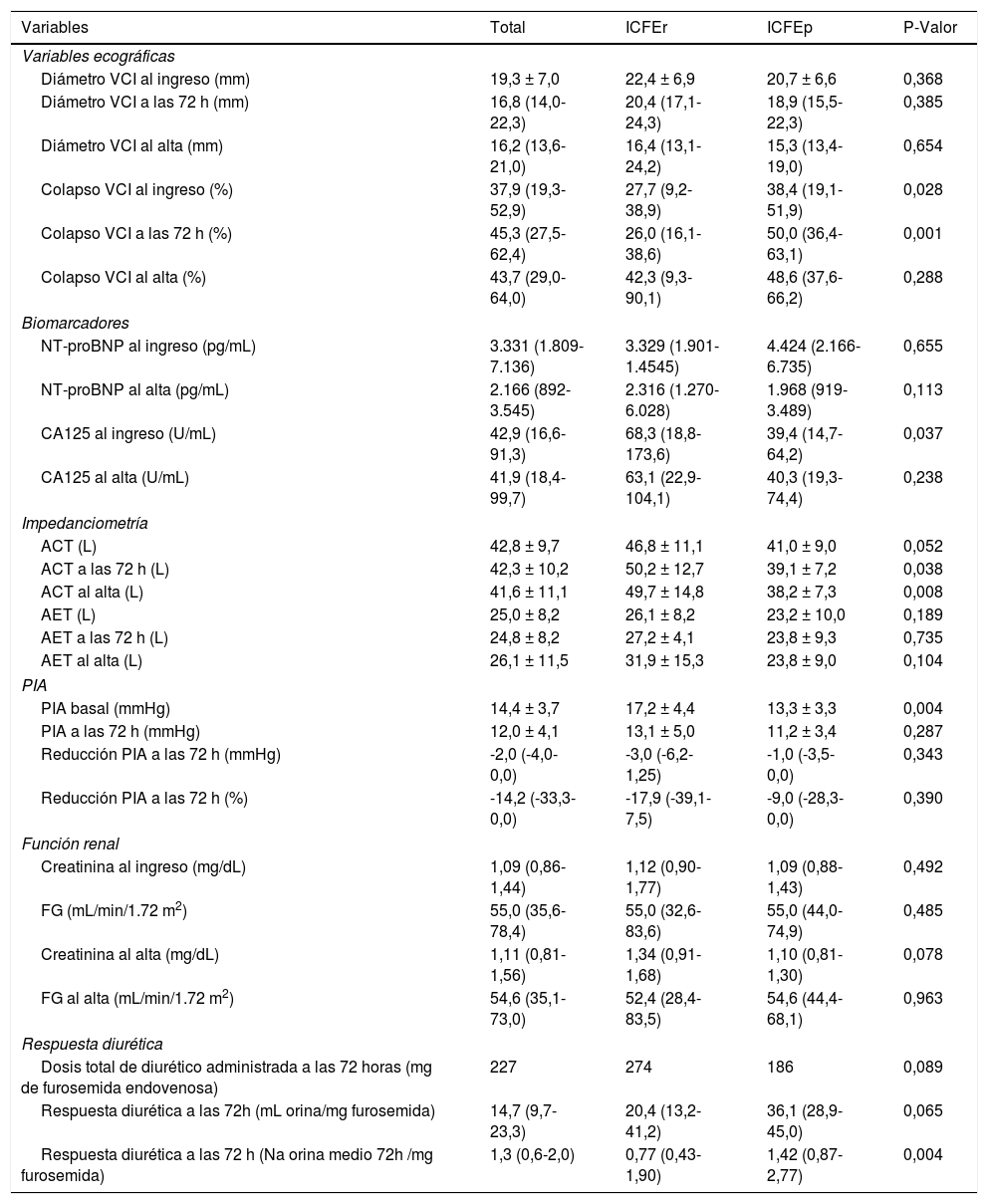El aumento de la presión intraabdominal (PIA) se ha correlacionado con elevación de la creatinina en pacientes con insuficiencia cardíaca con fracción de eyección ventricular izquierda gravemente deprimida (ICFEr). Sin embargo, dicha variable no se ha explorado en pacientes más estables o con insuficiencia cardíaca y fracción de eyección preservada (ICFEp).
Pacientes y métodoEstudio observacional, prospectivo y descriptivo consistente en la medición de la PIA en pacientes ingresados por insuficiencia cardíaca (IC) descompensada. Se estratificó la muestra según la fracción de eyección ventricular izquierda (FEVI) con un punto de corte del 50%, con el objetivo de analizar la PIA, así como las características basales y el grado de congestión empleando la ecografía clínica y la impedanciometría.
ResultadosSe incluyeron un total de 56 pacientes, 22 con ICFEr y 34 con ICFEp. Los pacientes con ICFEr presentaron una mayor prevalencia de cardiopatía isquémica (11 vs. 6; p = 0,010) y EPOC/asma (6 vs. 2%; p = 0,025). La PIA fue más alta en pacientes con ICFEr (17,2 mmHg vs. 13,3 mmHg; p = 0,004), sin diferencias en la función renal al ingreso según la FEVI (CKD-EPI creatinina) (ICFEr 55,0 mL/min/1,73 m2 [32,6-83,6] vs. ICFEp 55,0 mL/min/1,73 m2 [44,0-74,9]; p = 0,485). Los pacientes con ICFEr presentaron un perfil más congestivo estimado por ecografía (colapso de la cava inferior [26% vs. 50%; p = 0,001]), impedanciometría (agua corporal total al ingreso: 46 L vs. 41 L; p = 0,052 y a las 72 horas 50,2 L vs. 39,1 L; p = 0,038) y concentración de CA125 (68 U/mL vs. 39 U/mL; p = 0,037).
ConclusionesDurante los episodios de descompensación los pacientes con ICFEr tienen mayor elevación de la PIA y un mayor grado de congestión sistémica.
The increase in intraabdominal pressure (IAP) has been correlated with increased creatinine levels in patients with heart failure with severely reduced left ventricular ejection fraction (HFrEF). However, IAP has not been examined in more stable patients or those with heart failure with preserved ejection fraction (HFpEF).
Patients and methodWe conducted an observational, prospective descriptive study that measured the IAP of patients hospitalised for decompensated heart failure (HF). The sample was stratified according to left ventricular ejection fraction (LVEF), with a cut-off of 50%. The objective was to analyse the IAP, the baseline characteristics and degree of congestion using clinical ultrasonography and impedance audiometry.
ResultsThe study included 56 patients, 22 with HFrEF and 34 with HFpEF. The patients with HFrEF presented a higher prevalence of ischaemic heart disease (11% vs. 6%; p = 0.010) and chronic obstructive pulmonary disease/asthma (6% vs. 2%; p = 0.025). The IAP was higher in the patients with HFrEF (17.2 vs. 13.3 mmHg; p = 0.004), with no differences in renal function at admission according to the LVEF (CKD-EPI creatinine) (HFrEF 55.0 mL/min/1.73 m2 [32.6-83.6] vs. HFpEF 55.0 mL/min/1.73 m2 [44.0-74.9]; p = 0.485). The patients with HFrEF presented a more congestive profile determined through ultrasonography (inferior vena cava collapse [26% vs. 50%; p = 0.001]), impedance audiometry (total body water at admission, 46 L vs. 41 L; p = 0.052; and at 72 h, 50.2 L vs. 39.1 L; p = 0.038) and CA125 concentration (68 U/mL vs. 39 U/mL; p = 0.037).
ConclusionsDuring the decompensation episodes, the patients with HFrEF had a greater increase in IAP and a higher degree of systemic congestion.
Artículo
Diríjase desde aquí a la web de la >>>FESEMI<<< e inicie sesión mediante el formulario que se encuentra en la barra superior, pulsando sobre el candado.

Una vez autentificado, en la misma web de FESEMI, en el menú superior, elija la opción deseada.

>>>FESEMI<<<











